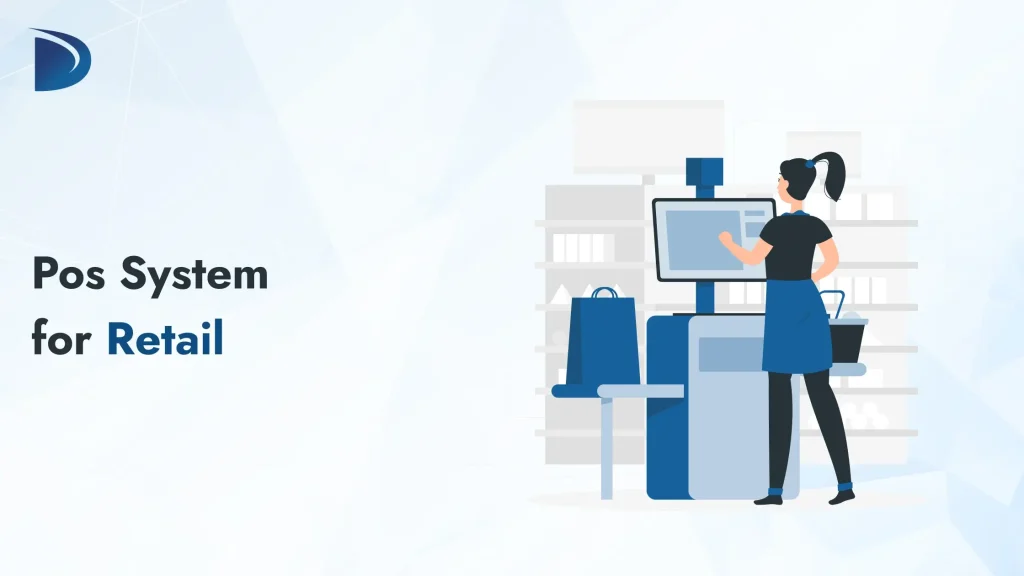Table of Contents
Running a retail store? It is wild. You need to keep track of stock, handle customers who “swear” they returned that item last week, and try to stop your team from turning the back room into a snack lounge. It is nonstop. That is where a robust POS system for retail can make a significant difference.
Modern POS systems do way more than just process payments. They help you remain updated on the inventory, manage staff, understand buying habits, and more. If the routine chaos feels like it’s taking over your life, it may be time for a more organized setup. Stick around, as we’re about to break down the POS Systems for Retail in plain, simple language.
What is a POS System?
A Point of Sale (POS) system is the technology retailers use to operate customer purchases and manage store activities. It serves as the central hub where sales transactions occur. Modern POS systems are equipped with advanced software and connected hardware that streamline everything from inventory tracking to customer management.
The hardware includes a tablet, a barcode scanner, a receipt printer, a card reader, and a cash drawer. They collaborate to create a seamless checkout experience for both staff and customers. On the software side, a POS system handles sales data, applies discounts, manages returns, and updates inventory in real time. It also stores customer information, tracks purchase history, and provides valuable insights through detailed reports.
Types of Retail POS Systems
POS systems for retail come in a few different types, each designed to suit different business sizes, models, and budgets. Here are a few of the most common types:
Cloud-Based POS Systems
Also known as web-based or SaaS POS systems, these run on the internet and stock data in the cloud. You can use them from any device with a browser and Wi-Fi.
On-Premises POS Systems
This POS system is fitted on local servers and runs on a closed network within the store. It offers more power over the software and data, but lacks the adaptability of cloud-based systems.
Mobile POS (mPOS) Systems
These are POS systems that run on smartphones. They’re light and thin, easy to use, and are paired with Bluetooth scanners and card readers.
How POS Systems Work in Retail Stores?
A POS system controls the entire checkout process, simplifying transactions while updating back-end activities in real time. Here’s how it all comes together, step by step:
Product Scanning or Selection
The process begins when a cashier scans the product’s barcode using a scanner. This displays the product information, including price, description, and any current discounts or promotions.
Total Cost Calculation
Once all items are scanned, the POS software works out the entire bill. It automatically adds sales tax, discounts, or loyalty points, so you don’t need to enter them manually. This ensures a fast and accurate checkout process.
Bank Communication
For card and digital payments, the POS system communicates with the merchant’s bank and the customer’s bank to verify the transaction. Once approved, the payment is processed within seconds.
Receipt Generation
After the payment is completed, the system creates a receipt. It can be printed on the spot or sent via email or SMS, at the customer’s choice.
Inventory Updating
Finally, the system automatically updates inventory levels. It deducts the sold items from stock and can trigger low-stock alerts or reorder notifications if thresholds are met. This real-time tracking helps avoid stockouts or overstocking.
Key Features of POS System for Retail
Sales Processing and Checkout
A POS system simplifies checkout by scanning items, applying discounts, calculating taxes, and accepting multiple payment methods, ensuring faster and more accurate transactions.
Inventory Management
Real-time inventory tracking keeps you informed about stock levels. It sends warnings when products run low, updates stock after every sale and can even automate reorders to avoid stockouts.
Customer Relationship Management (CRM)
By saving customer data and purchase history, POS systems enable you to craft more personalized promotions, manage loyalty programs, and enhance customer engagement with targeted marketing.
Reporting and Analytics
Structured reports give you clarity into sales patterns, top-selling products, staff performance, and profit margins, making it easier to plan and grow your business.
Multi-location and Omnichannel Capabilities
If you run your store in multiple locations or sell it online, a POS system can sync stocks, sales, and customer data across all platforms for a smooth process and better customer experiences.
Ease of Use and User Interface
Modern POS systems feature intuitive interfaces that are easy to learn and use. This decreases training time and helps your staff stay productive with fewer errors.
Benefits of Using a Retail POS System
| Benefit | Description |
| Faster Checkout Process | Speeds up billing with barcode scanning, auto price/tax calculations, and multiple payment options. |
| Accurate Inventory Management | Track stock levels in real time, prevent stockouts, and automate reordering when needed. |
| Improved Customer Experience | Stores purchase history and preferences to enable personalized service and loyalty programs. |
| Better Decision-Making | Provides detailed sales, inventory, and staff performance reports for smarter business planning. |
| Multi-Channel Selling | Syncs physical and online sales, giving customers a seamless experience across platforms. |
| Time and Cost Savings | Reduces manual tasks, lowers human errors, and increases team productivity. |
| Employee Management | Track staff hours, sales performance, and permissions to help manage roles and incentives. |
| Data Security | Protects customer and business data with encryption and secure cloud backups. |
Conclusion
Running a retail business is already a juggling act. Don’t let clunky checkout systems and messy inventory make it more complicated. A smart, easy-to-use POS system for retail can be your hero, bringing order to the chaos while you focus on your customers.
If you’re ready to ditch the guesswork and give your store the tech upgrade it deserves, we’ve got you. At Differenz System, we specialize in retail software development, creating custom POS solutions that truly match your business needs and retail style.
Let’s talk systems that work with you, not against you.
FAQs
Can a POS system handle returns and exchanges?
Yes. Most POS systems allow you to process returns, exchanges, and refunds efficiently while automatically updating inventory and customer records.
Can I manage multiple stores from a single POS system?
Yes. POS platforms support multi-store management, enabling you to track sales, inventory, and staff across multiple stores from a single dashboard.
Does a POS system support loyalty programs?
POS systems come with in-built loyalty program features or integrate with third-party tools to reward repeat customers, monitor points, and offer discounts or exclusive deals.
What happens if the system goes down during a sale?
POS systems offer an offline mode, allowing you to continue transactions even without an internet connection. Once the connection is restored, the data syncs automatically.
How often do POS systems update?
Cloud-based systems are routinely updated by the provider, connecting you to the latest features, security patches, and performance improvements without manual labor.

